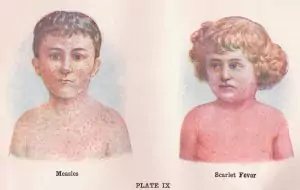 Measles is in the news again for a recent outbreak. In the U.S. about 300 cases have been reported as of late. However, measles is an old virus. The first emergence of measles was around 500 AD. Therefore, it has been around since early history, and continues to affect people, despite vaccinations. The virus produces a highly contagious disease, and that is one of the reasons it has lasted so long in the lives of humans. This essay will describe the signs and symptoms, causes, diagnosis, prevention, and treatment of this highly infectious virus.
Measles is in the news again for a recent outbreak. In the U.S. about 300 cases have been reported as of late. However, measles is an old virus. The first emergence of measles was around 500 AD. Therefore, it has been around since early history, and continues to affect people, despite vaccinations. The virus produces a highly contagious disease, and that is one of the reasons it has lasted so long in the lives of humans. This essay will describe the signs and symptoms, causes, diagnosis, prevention, and treatment of this highly infectious virus.

✅ AI Essay Writer ✅ AI Detector ✅ Plagchecker ✅ Paraphraser
✅ Summarizer ✅ Citation Generator
Commonly, children are infected with the virus. Though it is not usually fatal for adults, it can be for children. The signs and symptoms of measles last around 10-14 days subsequent to being exposed to the virus. The most common symptoms are: fever, dry cough, runny nose, sore throat, inflamed eyes, “tiny white spots with bluish-white centers on a red background found inside the mouth on the inner lining of the cheek — also called Koplik’s spots” (“Measles”), and a skin rash with flat blotches. The fever itself lasts for about four days to one week.
In terms of the causes of measles, it is simple. According to Children’s Hospital, “Measles is caused by morbillivirus, which is mostly seen in the winter and spring. It’s spread from one child to another through direct contact with discharge from the nose and throat. Sometimes, it is spread through airborne droplets (from a cough or sneeze) from an infected child” (“Measles (Rubeola) Symptoms & Causes | Boston Children’s Hospital”). The measles virus is a single-stranded, negative-sense, enveloped RNA virus. It can live up to two hours in airspace or surfaces (“Epidemiology and Prevention of Vaccine-Preventable Diseases”).
The good thing about measles is that it can be diagnosed rather easily. It has characteristic features that distinguish it from other diseases caused by viruses. Stated by Mayo Clinic, “Your doctor can usually diagnose measles based on the disease’s characteristic rash as well as a small, bluish-white spot on a bright red background — Koplik’s spot — on the inside lining of the cheek. However, many doctors have never seen measles, and the rash can be confused with a number of other illnesses. If necessary, a blood test can confirm whether the rash is truly measles” (Measles”). However, as told above, measles is more rare than other diseases, so it is important to take the appropriate tests to determine the validity of your doctor’s claims.
The bad news is that receiving the measles virus is hard to avoid due to its highly infectious and contagious nature. There is not much in the way of recommendations. According to Children’s Hospital, “Since the use of the Measles, Mumps, Rubella (MMR) vaccine, the number of children infected with measles has dropped by 99 percent. About 5 percent of measles are due to vaccine failure. The vaccine is usually given when your child is 12 to 15 months old, and then again when he is between 4 and 6 years old” (“Measles (Rubeola) Symptoms & Causes | Boston Children’s Hospital”). So, getting vaccinated is our best bet at fighting off the virus and becoming immune to it.
If you happen to get infected with measles, there are various ways to treat it. However, there is no medicine that directly treats measles. With that said, these are the various treatments: “acetaminophen to relieve fever and muscle aches, rest to help boost your immune system, plenty of fluids (six to eight glasses of water a day), humidifier to ease a cough and sore throat, [and] vitamin A supplements” (“Measles: Symptoms, Diagnosis, and Treatments”). It is best to combine all these treatments for the best effect.
Measles is an ancient virus that has adapted and mutated throughout history. Currently, it is making a comeback. However, getting vaccinated is the surest way of avoiding getting infected by this contagious virus. As soon as you notice any signs or symptoms of measles—fever, dry cough, runny nose, sore throat, inflamed eyes, Koplik’s spots, and a skin rash with flat blotches—then head to your doctor for a diagnosis and recommendations for treatment.
Works Cited
“Measles.” Mayo Clinic, Mayo Foundation for Medical Education and Research, 7 Sept. 2018, www.mayoclinic.org/diseases-conditions/measles/symptoms-causes/syc-20374857.
“Measles (Rubeola) Symptoms & Causes | Boston Children’s Hospital.” Boston Childrens Hospital, www.childrenshospital.org/conditions-and-treatments/conditions/m/measles-rubeola/symptoms-and-causes.
“Epidemiology and Prevention of Vaccine-Preventable Diseases.” Centers for Disease Control and Prevention, Centers for Disease Control and Prevention, 24 July 2015, www.cdc.gov/vaccines/pubs/pinkbook/meas.html.
“Measles: Symptoms, Diagnosis, and Treatments.” Healthline, Healthline Media, www.healthline.com/health/measles#treatment.
Follow us on Reddit for more insights and updates.





Comments (0)
Welcome to A*Help comments!
We’re all about debate and discussion at A*Help.
We value the diverse opinions of users, so you may find points of view that you don’t agree with. And that’s cool. However, there are certain things we’re not OK with: attempts to manipulate our data in any way, for example, or the posting of discriminative, offensive, hateful, or disparaging material.